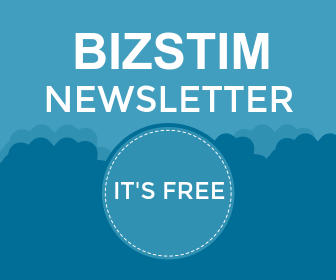
INTRODUCTION TO BIZSTIM
Bizstim business management application software is geared towards service-based companies. The app was designed by a former small business owner who took what he learned from running a tutoring company and applied it to the development of this software. Three important goals for the app were established, they include:
- provide features to assist business operations (client management, human resources, finances, and scheduling)
- use a minimal approach to the applications design (keep the complication to a minimum and focus on user experience)
- set an absolute fee for using the application instead of tying its price to the size of the business
If you find yourself relating to this story then you can appreciate the need for a business tool that cuts down on redundancy and provides a mechanism tying together major components of business operations.
BIZSTIM FOUNDER

Christopher Binns is the founder of Bizstim and ran a tutoring company for 5 years. Over 250 clients were services and 50+ teachers were employed. Due to family considerations, Christopher was forced to discontinue the business and become a stay-at-home dad for his two young children. During this time; between cleaning diapers and wiping noses, Christopher thought about the software he used to manage his company. He asked himself, what would the perfect tool look like?
Even though his tutoring company was small, he collected a lot of data in a number of different formats. He employed a Wordpress site to advertise his services with a resume form connected to the website. There were multiple excel spreadsheets to manage prospective clients, client information, revenues, wages, promotions, and taxes. A software platform with a monthly fee organised tutoring sessions; tutors and clients. A litany of post-it notes and loose papers, and workbooks stored other information that did not fit into the other data collection mediums.
Daily operations utilized different processes that were disjointed and prohibited streamlining. Keeping the business organized and running efficiently was daunting and a great deal of time was wasted on non-revenue generating redundant tasks. Remember, this is a very small business. Scaling the business up would have been problematic if not impossible.
If you find yourself relating to this story then you can appreciate the need for a business tool that cuts down on redundancy and provides a mechanism tying together major components of business operations.
Using more than one application is costly and requires a greater amount of time to learn.
A BROADER APPROACH
A broad approach is the opposite of a specific approach. Specific approaches focus on a single business component. Examples of specific approaches to business management are accounting programs or client relations management programs, or human resources programs. These specific approaches to business management are the norm in the marketplace today. They tend to go into great detail with many pages of complicated data. Companies utilizing these applications must use a combination of them. Using more than one application is costly and requires a greater amount of time to learn. Furthermore, these programs fosters division within a company because there isn't a way to share information between platforms. These drawbacks can be resolved by using a broad approach to business management.
Why isn't broad approaches the norm? The answer to this question is ironically simple. Broad approaches are more costly to develop, and require knowledge in multiple business management disciplines. In short, it's a lot harder to implement, and easy to screw up. The obstacles to broad approaches are sufficient enough to persuade the most adventurous programmers. For the most part, broad approaches tend to exist in proprietary circumstances; owned by large companies with the funds and time to pay programmers to build an application that meets their specific needs.
Bizstim business management software is unique because its founder was a sole proprietor who learned how to manage all facets of a small business. Christopher applied his knowledge as a business operator and successfully designed an application capable of assisting within a broad context. Moreover, because he was not a programmer, he considered what a business owner actually needed and wanted, and learned how to program those features afterwards. This can best be described as a business-centered approach to application design.
THE MINIMALIST IDEOLOGY
Keep-it-simple-stupid or KISS. KISS is at the heart of the minimalist coding ideology. Minimalism doesn't cut back on vital features. Instead, minimalism identifies which features are vital features and which features are non-vital features. Non-vital features are omitted from the application.
Furthermore, minimalism attempts to create pages that are more utilitarian. Too often program designers focus on reducing database queries per page. Having fewer queries in the page makes for a faster loading page, but consequently increases the number of pages a user is required to navigate. We know that pages embedded within pages with complicated navigation decreases the user experience. When users can't find something, or must interpret data across pages, they don't like using the program and productivity declines.
Our Smart Dashboard takes the precepts of minimalist ideology when displaying data to specific user types. Administrators and Staff are only shown data that require their attention. When these tasks are completed, the data disappears. In this way, a quick glance of the dashboard tells them a lot about their work flow. All they had to do is login and look at the first page that appears to them. All of the business data is still available, and they can navigate to it, but it just isn't needlessly occupying their attention.
On the other hand, contractors and clients are shown a dashboard that considers what they look for 90% of the time. This means for 9 out of 10 logins the client or contractor will see what they need on the dashboard without having to navigate the application. This results in increased use of the business tool. When your clients and contractors are able to find what they need, they don't contact administration and a time savings is realised.
ABSOLUTE FEES VERSUS DYNAMIC FEES
In an effort to appear price competitive many software companies use dynamic fees. A dynamic fee is a fee that is variable and changes over time and is usually tied to the size of your company. Thus, the initial monthly fee may be low, but as the business grows, the fee consequently increases. In the end, business owners tend to pay much more for these plans than they would if they had an absolute fee option.
Dynamic fee platforms understand that once a business has invested time and money in storing its data to their application, moving to a more cost effective service is difficult and unpredictable. Business owners will pay more in the long run to prevent losing data and affecting the quality of their service.
Don't be fooled by dynamic fees. Consider how many clients you need to break even with an absolute fee option. Here is an example:
| Dynamic Fee Option | Absolute Fee Option |
|---|---|
| 21.99 / month | 29.99 / month |
| 50 cents per client | N/A |
At face value, the dynamic fee option requires the lowest monthly fee, however, it also has a fee of 50 cents per client. The difference is 8 dollars per month. As soon as your business has more than 16 clients, you will pay more for a dynamic fee service than you would for an absolute fee service.
Don't plan to fail! For most businesses, having fewer than 16 clients would be considered a colossal failure. How many clients would you need to be moderately successful? If this number is more than 16, go with the absolute fee option.
Absolute fee options are usually more cost effective and they are more fiscally sound. It is much better to know what you will be spending from month to month.
Our business management software is business-centered, created by a business person not a career programmer, and solves many of the problems plaguing our competitors.
CONCLUSION TO BIZSTIM HISTORY
Our business management software is business-centered, created by a business person not a career programmer, and solves many of the problems plaguing our competitors. We don't attempt to fool you with deceptive pricing options. We've created an application that assists with a broad range of business operations and does so with effortless simplicity.
In your experience, are business software applications too complicated?







